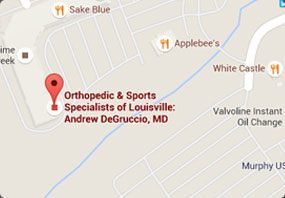Meniscal Tears in the Knee

In the knee the meniscus is the load-bearing cartilage ring. They are akin to tires on your car. There are two in each knee, one on the medial side of the joint (inside aspect of the knee) and one on the lateral side of the knee (outside aspect of the knee). They are C-shaped and very rubbery. These meniscal cushions are very important to the knee for distribution of weight forces through the joint, to reduce the stress on the articular cartilage (cartilage on the end of the bones). Injury to the meniscus has been shown to predispose to early arthritis in the joint.
Injury to the meniscus usually occurs with sudden twisting and shearing forces. Sometimes unusual axial load forces can also injure the meniscus. Sometimes the meniscus is more prone to injury in rare circumstances where it is abnormally large, which is a well known anatomical variant called a discoid meniscus. As we get older sometimes the meniscus will tear just from normal activities, if the tissue has become degenerative, like a "blow-out" of a tire on your car which has had too many miles put on it.
The signs of a torn meniscus include knee pain, swelling, catching and popping. The pain can come and go, or be more activity specific. "Giving way" can occur as a result of pain induced as meniscal fragments catch in the joint. The meniscus can frankly get stuck in the joint at times creating a "locked knee". Some meniscal tears may create very little problems for the knee, and the patient may choose to live with it that way. In other cases, the meniscal tear will drastically impact daily activities and sporting endeavors, and may require surgery.
The cartilage rings of the knee do not show up on plain x-rays. Nevertheless, initial work-up for a potential knee meniscal injury includes a history, physical exam, and plain x-rays. An MRI may become necessary. On MRI the meniscus is well-visualized, as well as all the other important ligamentous structures. Often, meniscus tears occur at the same time as ligament tears, and this is why an MRI is helpful. Once a meniscus tear is identified, treatment is initiated, and in most cases will include surgery.
Since the meniscus is critical to the longevity of the knee, preservation or repair of the meniscus is the optimal solution. Unfortunately, many tears do not lend themselves to repair, and, hence, a portion of the meniscus has to be trimmed out. The determination of repair ability is often made at the time of surgery. Surgery involves arthroscopy, which is a minimally invasive diagnostic and therapeutic procedure done through two small incisions about the front of the knee. The surgery usually takes less than an hour to perform, but does usually require a general anesthetic. Since the surgery is done as an outpatient, early rehabilitation can be expected. If the meniscus is repaired, then restrictions will be necessary for several months, but if no repair is performed, full recovery may be expected within the month.
Not all knee pain suggests a torn meniscus. Therefore, concerning knee pain should be discussed with a Sports specialist, who can initiate the evaluation of the problem, and plan effective treatment.







